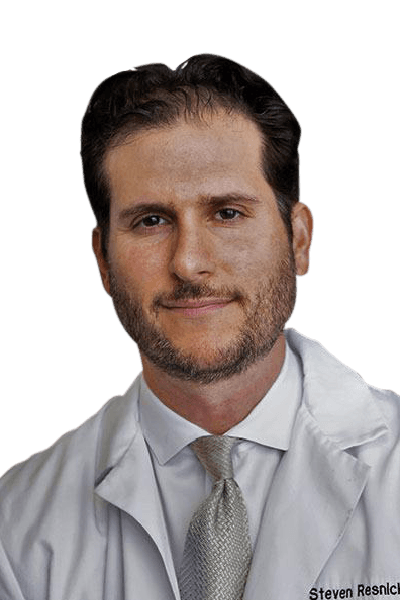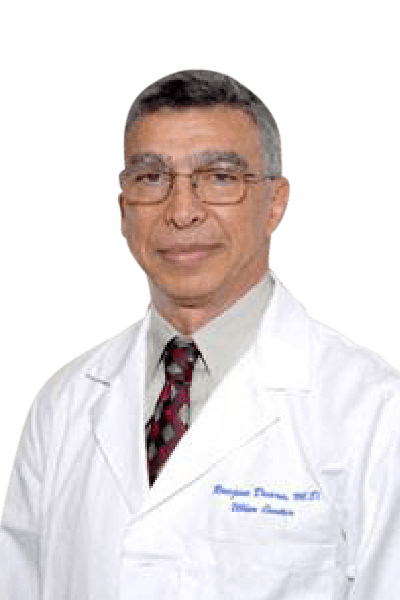Neurology
Mount Sinai’s Department of Neurology addresses a wide array of neurological conditions, such as headaches, seizures, nerve damage, and hearing disorders. Our multidisciplinary approach provides a full range of services, from sophisticated diagnostics to advanced rehabilitation resources in virtually every neurological field.
As part of Mount Sinai’s Neurologic Center of Excellence, we offer our patients a comprehensive level of care and services, which include the following:
24-hour Ambulatory Electroencephalogram
The 24-hour ambulatory electroencephalogram (EEG) records brain activity for 24 hours on a small digital recorder that is worn comfortably around the waist or shoulder. Electrodes are applied to the scalp with an adhesive, and then the patient goes home with a diary. Throughout the day, the patient records his or her activities and any symptoms during the 24 hours.
An EEG helps doctors diagnose a variety of neurological problems, from common headaches and dizziness to seizure disorders, strokes, and degenerative brain disease. The highly sensitive equipment records the brain’s electrical activity (known as brain patterns). This helps doctors ascertain a variety of conditions, such as changes that induce, seizures, psychiatric symptoms, and disabilities in children.
Auditory Evoked Response
Brainstem auditory evoked potential (BAEP) or auditory brainstem response (ABR) equipment provides doctors valuable data in evaluating the auditory nerve pathways between the brain stem and the ears. Electrodes are placed on the scalp and on each earlobe. Clicking noises or tones emit through earphones while the electrodes pick up the brain’s response and record it on a graph. Earphones deliver a series of clicks or tones to each ear separately.
Evoked potential (EP) testing records the electrical activity from the brain, spinal nerves, or sensory receptors in response to specific external stimulation. Each type of EP looks at a different neurological pathway, helping doctors diagnose a number of different neurological problems, including spinal cord injuries, acoustic neuroma, and optic neuritis.
Electroencephalogram
An electroencephalogram (EEG) helps doctors diagnose a variety of neurological problems, from common headaches and dizziness to seizure disorders, strokes, and degenerative brain disease. The highly sensitive equipment records the brain’s electrical activity (known as brain patterns). This helps doctors ascertain a variety of conditions, such as irreversible brain death, seizures, or changes that induce psychiatric symptoms and disabilities in children.
The EEG is conducted with electrodes on the scalp that record electric brain activity over a 90-minute period as the patient sits in a relaxed state. Sometimes participants are asked to hyperventilate, sleep, or watch a strobe light in order to record different brain patterns.
Electromyography
An electromyogram (EMG) is a medical technique that uses small needles to evaluate and record the properties of resting or contracting (in either a gentle or vigorous fashion) muscles. The test is often used to find the cause of muscle weaknesses, such as paralysis, involuntary twitching, and abnormal levels of muscle enzymes. It can help diagnose neuromuscular disorders, such as motor neuron disease, neuropathy, nerve damage, and muscle damage. Or it can ascertain if a patient is avoiding muscle use because of pain or lack of motivation during physical therapy. EMG is also used in biofeedback studies and training, helping migraine patients learn to ease muscle tension in the face, neck, and shoulders.
Nerve Conduction Studies
A nerve conduction study (NCS) uses electrodes to read the electrical activity from a muscle connected to a nerve or specific nerve tissue. Patients referred for NCS tests suffer from nerve conditions that produce numbness, tingling, pain, loss of sensation, or neurological diseases affecting primarily the peripheral nervous system. Common disorders diagnosed by NCS are peripheral neuropathy, carpal tunnel syndrome, ulnar neuropathy, and Guillain-Barré syndrome.
Somatosensory Evoked Potential
Somatosensory evoked potential (SSEP) assesses whether pathways from the nerves can transmit sensory information like pain, temperature, and touch to the cerebral cortex. A small electrical current is applied to the skin overlying nerves on the arms or legs. Each leg or arm is tested separately.
SSEP is used to ascertain nerve damage from such conditions as a bone spur, herniated disc, or other source of pressure on the spinal cord or nerve roots. During spine surgery, SSEP is used to double-check whether the sensory part of the nerve is working correctly.
Evoked potential (EP) testing records the electrical activity from the brain, spinal nerves, or sensory receptors in response to specific external stimulation. Each type of EP looks at a different neurological pathway, helping doctors diagnose a number of different neurological problems, including spinal cord injuries or acoustic neuroma.
Visual Evoked Potential
Visual evoked potential (VEP) evaluates the visual nervous system from the eyes to the occipital cortex (visual cortex of the brain). The patient is usually asked to stare at an alternating checkerboard pattern on a video screen or look at flashing lights. Each eye is tested separately.
When repeated VEP stimulation causes no changes in EEG results, the subject’s brain isn’t receiving visual information. This makes VEP useful in diagnosing blindness in nonvocal patients. Meanwhile, a delayed VEP result can ascertain conditions like multiple sclerosis or optic neuritis.
Evoked potential (EP) testing records the electrical activity from the brain, spinal nerves, or sensory receptors in response to specific external stimulation. Each type of EP looks at a different neurological pathway, helping doctors diagnose a number of different neurological problems, including spinal cord injuries or acoustic neuroma.
Our Physicians
Steven J Resnick, DO
Chief, Division of Neurology
Medical Stroke Director
- Neuroscience
- Neurology
- Vascular Neurology
- Mount Sinai Medical Center (Main Campus)
- 305.674.2121
Ranjan Duara, MD
Medical Director, Wien Center for Alzheimer’s Disease and Memory Disorders
- Neuroscience
- Neurology
- Alzheimer’s Disease
- Memory Disorders
- Mount Sinai Medical Center (Main Campus)
- (305) 674-2543



